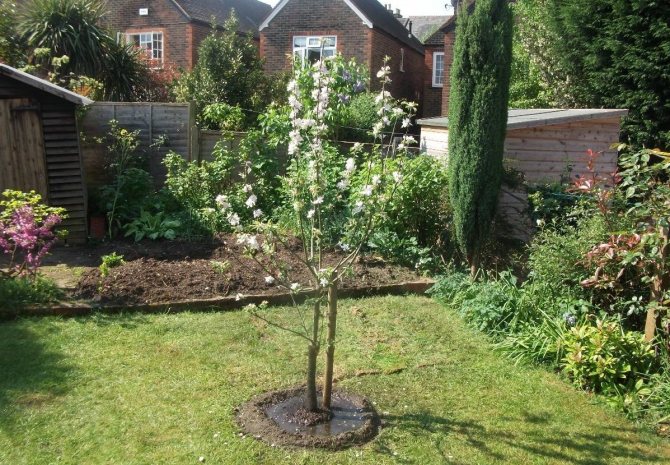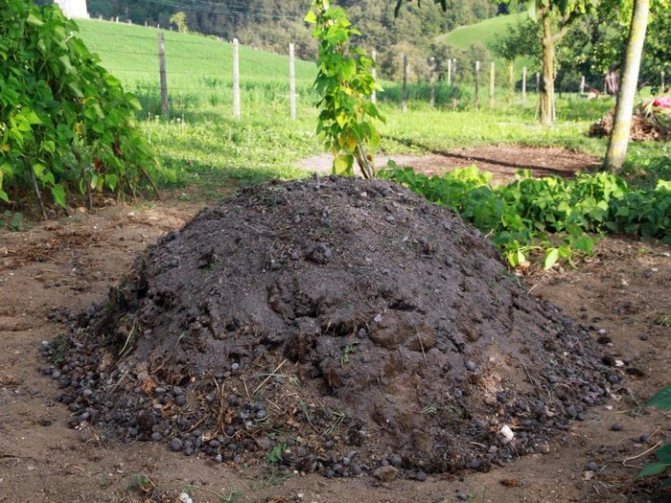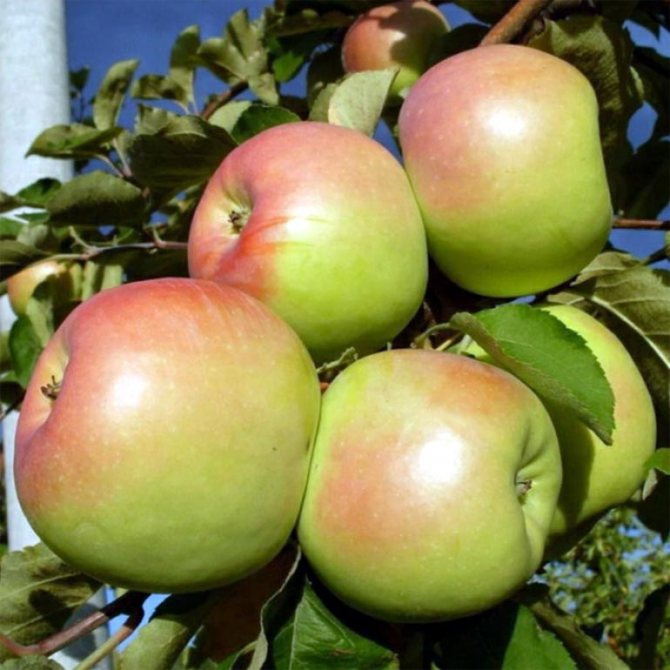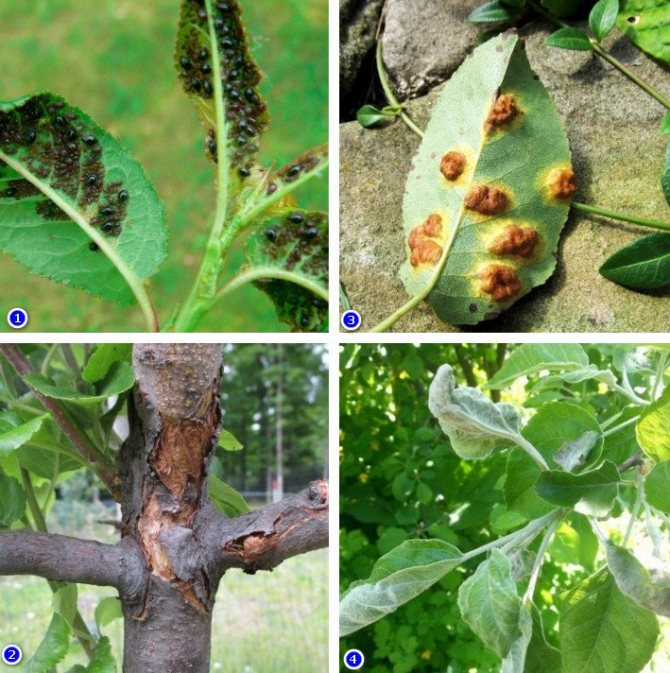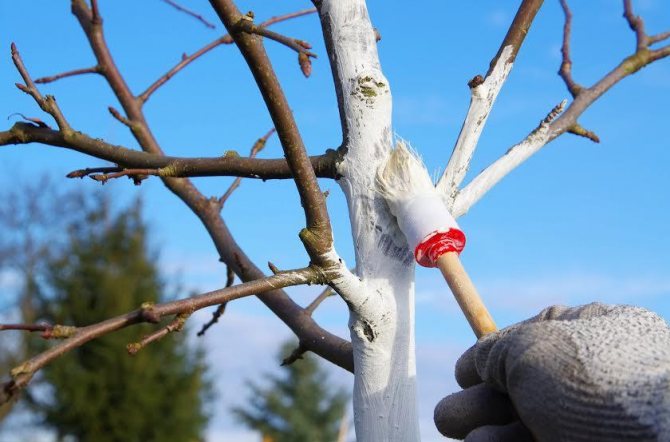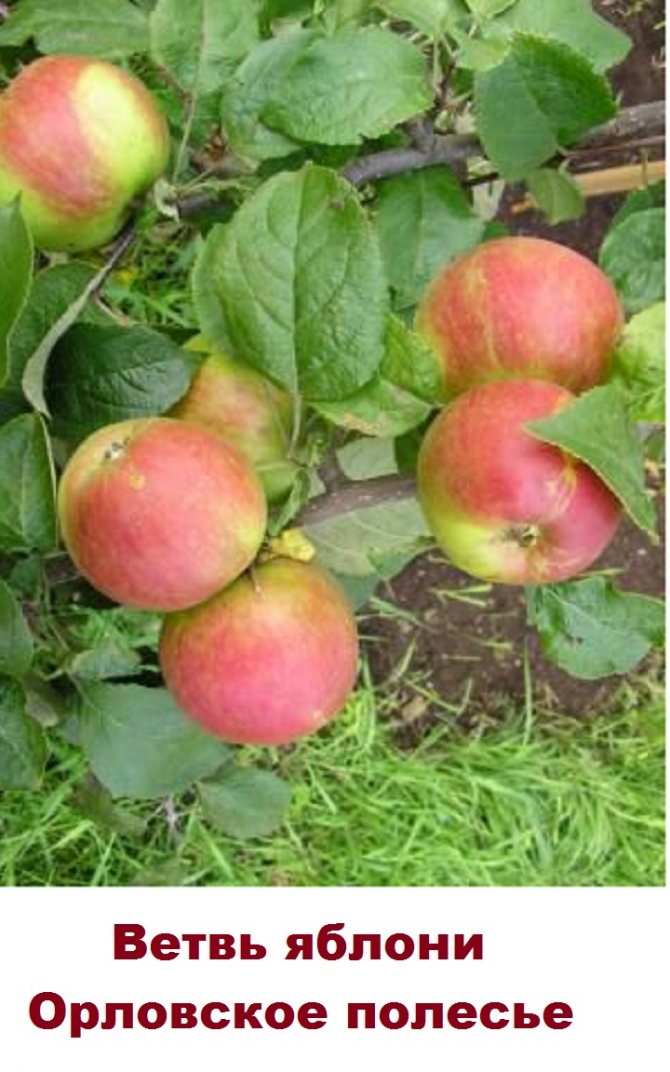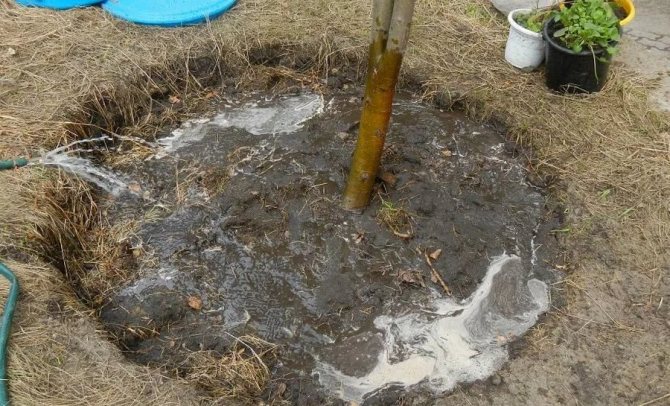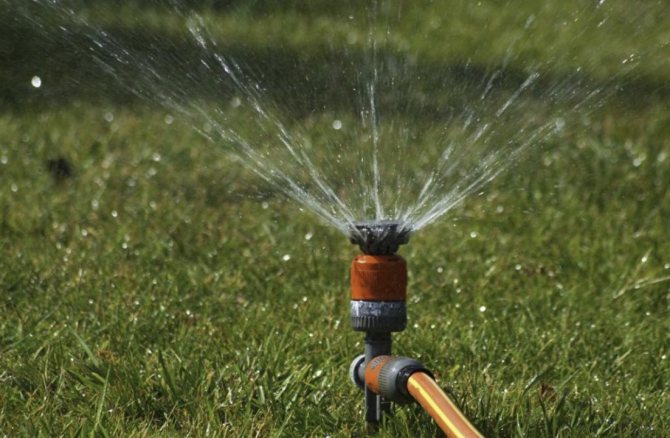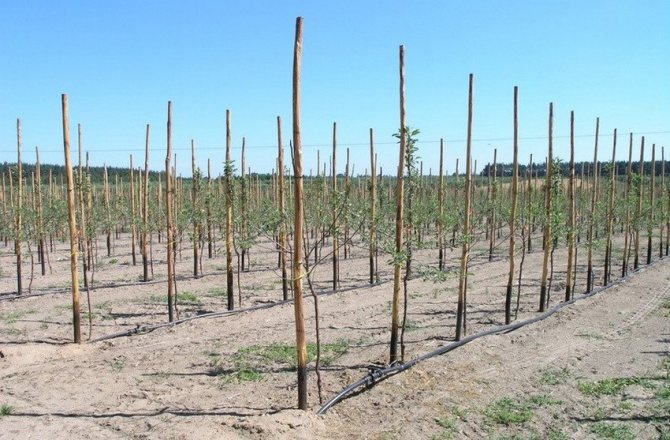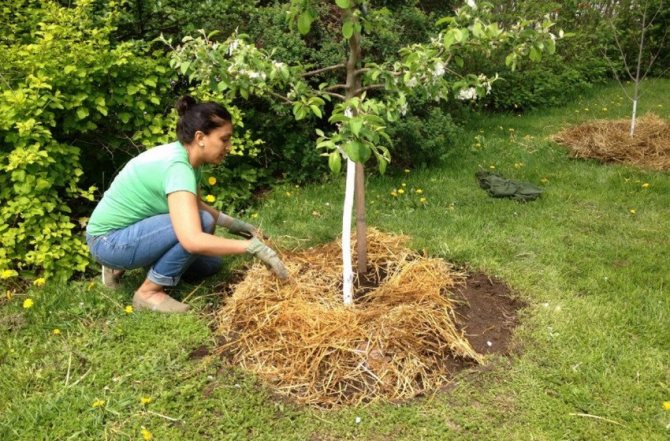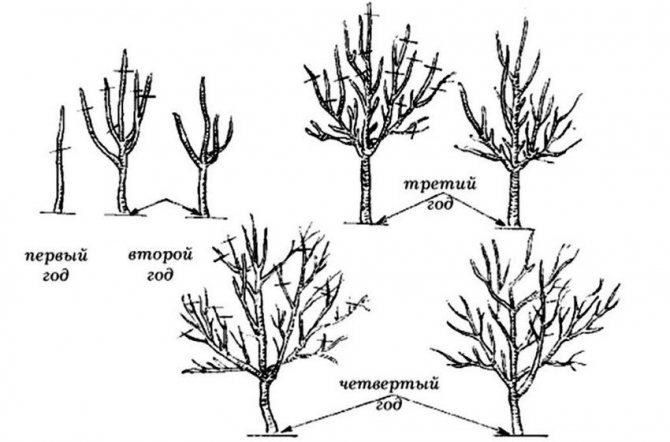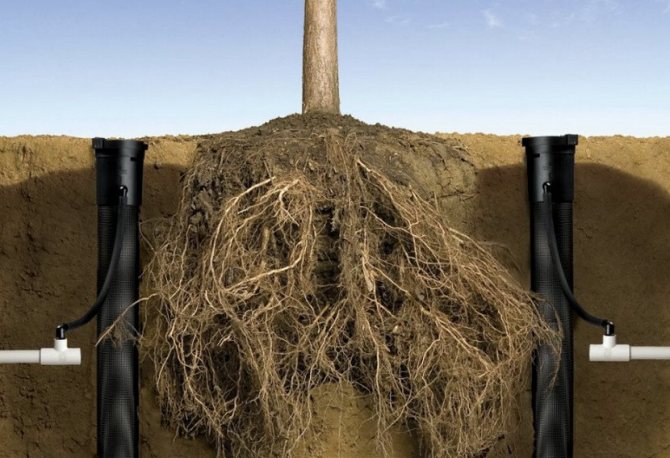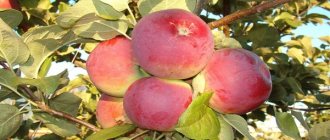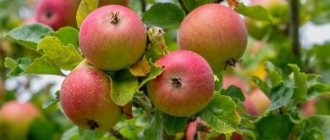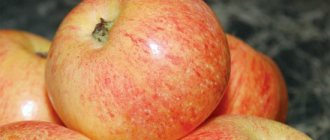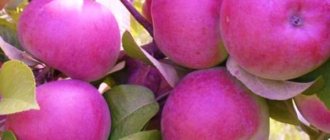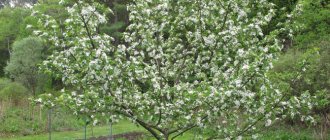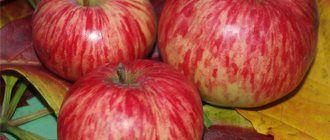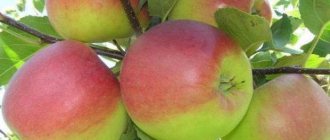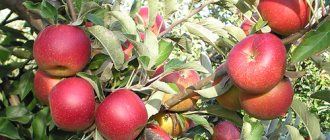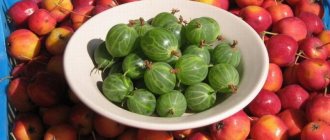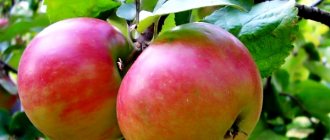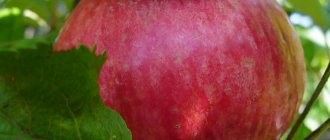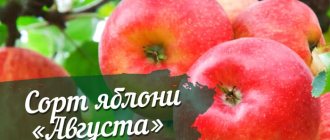The apple tree Orlovskoe Striped appeared at the Oryol experimental station in 1957. It was obtained by Russian breeders Sedov and Trofimova during the hybridization of varieties Macintosh and Bessemyanka Michurinskaya. In 1967, the variety was officially recognized as an elite variety. The variety is zoned for the Central Black Earth, Central regions of Russia. The apple tree is grown in the Central, Middle Volga, Northwestern, Northern, Black Sea, Volgo-Vyatka regions. Many gardeners grow this apple tree and love it for its delicious and aromatic fruits.
Description of the variety
Appearance
Apple tree growing medium... By the tree rounded crown... The bark is brown and smooth. The apple tree has thick dark cherry shoots, large bright green leaves. The flowers are large.
Fruit
Large fruit 120-150 g, apple-shaped round-conical... The main color is golden; cover color - implicit stripes and specks of bright purple over a pinkish blush. Subcutaneous points are easy to spot... The pulp is creamy.
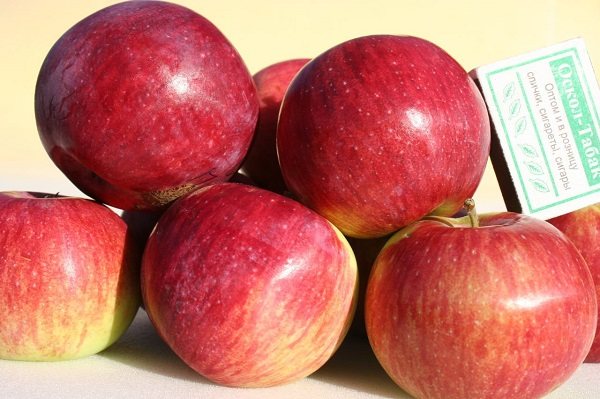
Ripe apples of Orlovsky striped.
Important! The taste is more acidic than sweet.
Pulp composition:
- Sakharov 10.1%,
- Ascorbic acid 8.2 mg / 100 g,
- Titrated acids 0.78%,
- P-active substances (bioflavonoids with vitamin P) 212 mg / 100 g,
- Pectin substances 10.7%.
Advantages and disadvantages
Dignity varieties:
- The apple tree is fast-growing, as apples are harvested for 4 years.
- The fruit tastes great and looks good and sells well.
- Trees are resistant to the most common apple disease - scab.
- A fairly large number of apples are harvested from the tree, up to a maximum of 60-80 kg.
- The fruits can be stored for quite a long time when comparing this variety with others. In the refrigerator at a temperature of + 1-2 ° C, they are stored until January.
Disadvantage that apples very thin skin, therefore, it is required to remove them from the tree very carefully.
Tree height and crown width
High apple tree on a vigorous rootstock up to 5 m... The crown is rounded, medium thickened. Crown width from 3.8 to 4.5 m.
Productivity and tasting evaluation
The variety is classified as one of the most productive, harvested 200 c / ha... Only the Jonathan variety has a higher yield. From an adult tree of the Orlovskoye striped variety at the age of 7-8 years, you can collect 40-50 kg, and from an apple tree at the age of 10-15 years up to 60-80 kg of apples.
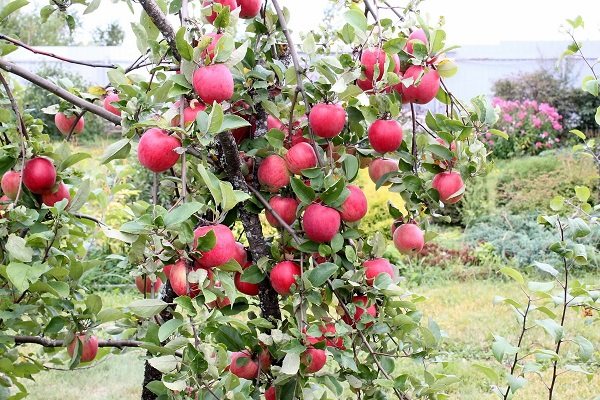

Orlovskoe striped can produce 60-80 kg of apples.
Fruits are rated at 4.2-4.6 points on a 5-point scale.
Winter hardiness
Frost resistant sufficient for growing in the Oryol region... But trees can be grown and in the North, only in stanza form.
Shale form - the apple tree is shaped so that the main skeletal branches are near the soil, so that in winter they are under the snow, this gives the tree much greater winter hardiness.
Disease resistance and lifespan
Variety scab resistant. Wood can live up to 40 years.
Pollinator varieties
It is best to choose varieties as pollinators so that they bloom and have apples tied at the same time as the pollinated variety. For example, suitable for the Orlovskoye striped variety:
- Anise striped,
- Paping,
- Autumn striped
- Slav,
- Scarlet anise,
- Titovka.
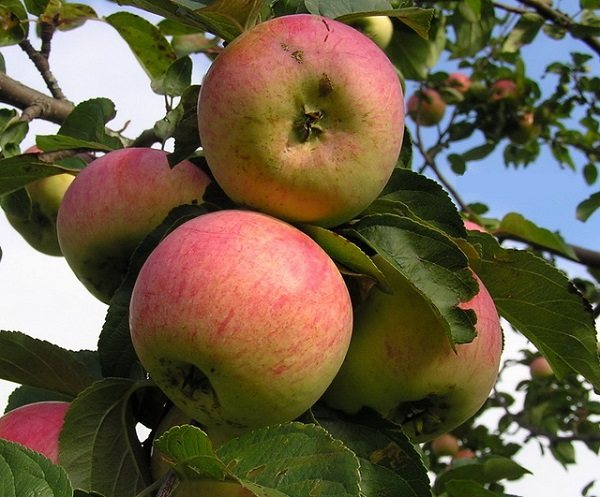

Anise striped.
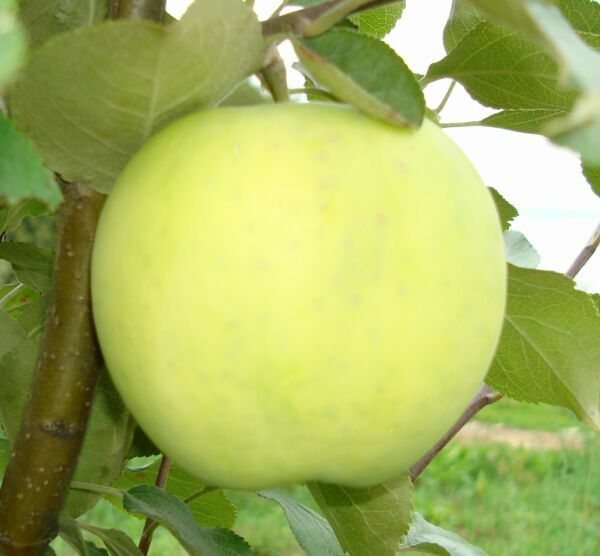

Folding.
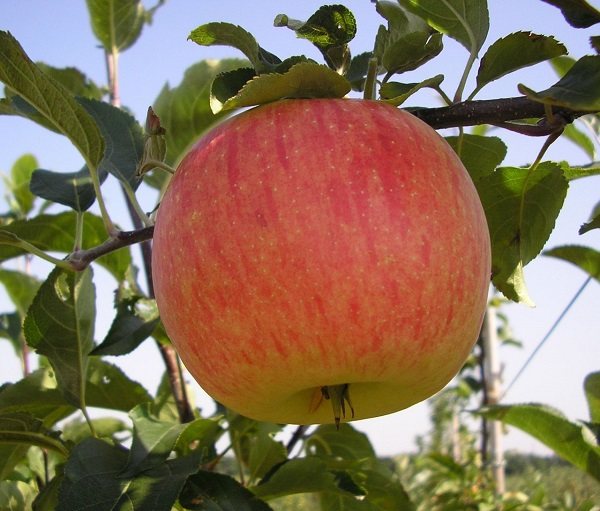

Autumn striped.
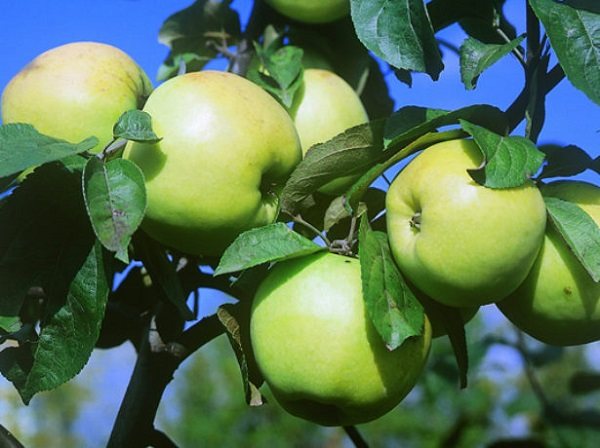

Slav.
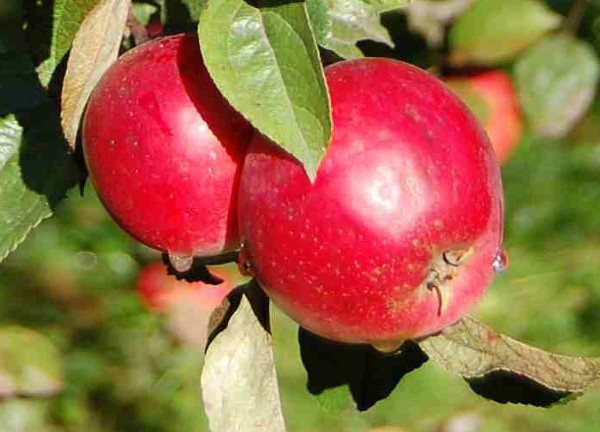

Scarlet anise.
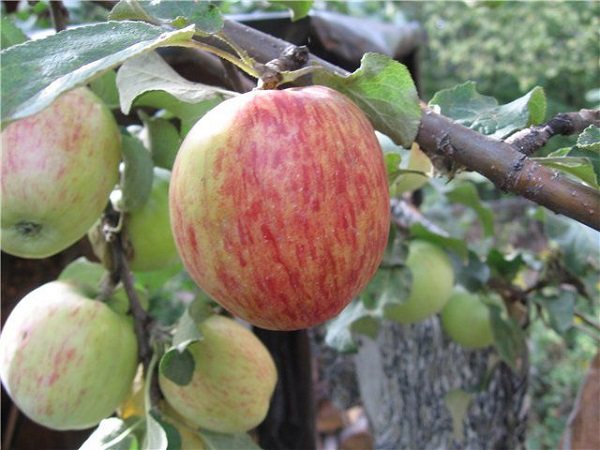

Titovka.
The beginning of fruiting
The apple tree is classified as a fast-growing tree, since a vigorous tree in the 4th year after disembarkation apples appear. And the buds swell in early April.
Flowering period and fruit ripening period
The variety blooms in April, May. Apples ripen in early autumn.
Removable ripeness and shelf life of fruits
Early autumn remove apples, as they have a very delicate skin. It is impossible for them to crumble themselves.
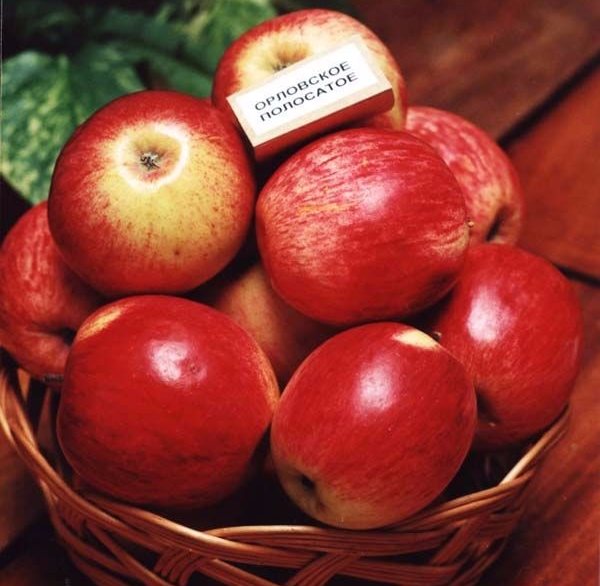

Ripe Orlovsky striped apples have a very delicate skin.
Important! The fruits are stored for about 4 months in the refrigerator, while the apples do not lose their taste.
Characteristic
The characteristic of the apple tree indicates that this tree is mainly of medium height. The crown is weighty, rounded, with thick flexible branches at the tips. This type of apple tolerates winter frosts well, and pleases farmers with a rich harvest.
Apple-tree Orlovka has growth and fruiting branches. Some fruits are located on annelid processes, while others are located on soft twigs. The tree can reach 15 m in height. The leaves are usually rounded with denticles along the edges.
When the apple orchard blooms, a pleasant aroma is felt. And the flowers on the trees are shaped like a bowl. The buds are white and pale pink. A variety of the apple-tree variety Orlovskaya is distinguished by the color of the fruits (crimson-red stripes). At maturity, the tone turns yellow.
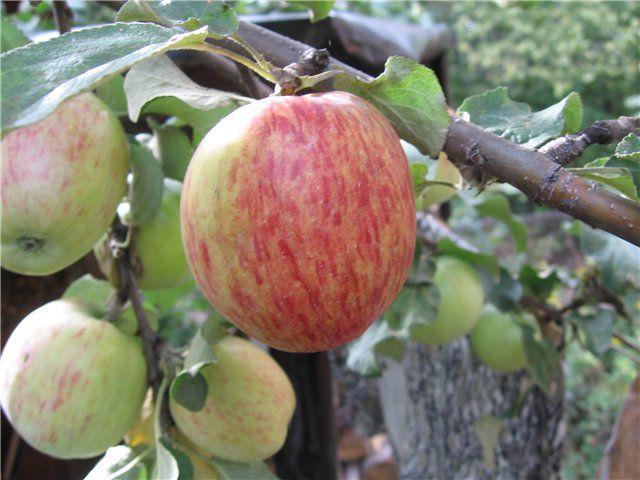

Apple Orlovskoe Striped
The fruit stalks of varietal apples are short and thin. The shape of the fruit is familiar, round and slightly oblong. The stalk is brown, and the skin is thin and delicate, so to avoid damaging the apples, you need to pick the fruits carefully. If the top layer is damaged, the apples will not last long.
Testimonials
Kolyadin Roman, agronomist from the Moscow region, Stupinsky district, p. Khatun. “I think the apples look like a solid top five, and the variety is also high-yielding. The main advantage of the variety is the chipping pulp, like the Macintosh variety, and the fact that the apples are large. "
Vitaly, Ufa. “After storage, apples are very tasty. In terms of resistance to spring frosts, the Orlovskoye striped variety can be given a four out of 5. "
Alexey P.P., a plot in the Orekhovo-Zuevsky district. "The taste of apples resembles the Alcmene variety, the pulp is juicy, the taste is excellent, but the resistance to frost is higher."
What amateur gardeners say
Feedback from users growing apples Orlovskoe striped:
“Apples of this variety have a good taste, slightly sour. One of the trees in our garden is already more than 20 years old, but the fruit comes out every year. However, you have to take them off very carefully, with care, since the skin is easy enough to wrinkle. "
“I grow this variety of apples among other apple trees, but all the household members love it. The fruits are very tasty, delicate in taste and juicy. I put the apples in the cellar for storage. I wrap each fruit in paper and carefully lay it out in a wooden box. The apples are kept until the New Year holidays. "
"The magnificent and delicious variety of dessert apples" Orlovsky striped "will make your table richer. This apple variety grows almost everywhere in Russia. For the winter, they are stored in dark cellars, having previously wrapped them in plain newspaper. From them you can make a large variety of blanks for future use for the winter. I think they are a great fruit plant. "
Landing
Seat selection
Tree you need a place with good lighting, otherwise, the sugar content of apples may decrease and the yield may decrease.
If the place where you want to place the apple trees can floodthen you need to do drainage or plant trees on a hill.
Yablone sandy stones, loams are suitable, she needs land with weak acidic properties, close to neutral, pH 5.6-6.0.
Seedling preparation
Important! If you bought a seedling without soil, which has a bare root system, then you need to cut off 90% of the leaves, leaving several leaves on each shoot.
If you purchased a seedling in springthen you can immediately prune branches... In no case root can not be cut, since the more of them, the faster and better the apple tree will take root.
Watch a video on how to prepare apple seedlings for planting:
Pit preparation
First dig up land, bring fertilizers, and then dig holes about 1 m in diameter and up to 0.8 m in depth, they are dug at a distance of 3-4 m from each other.
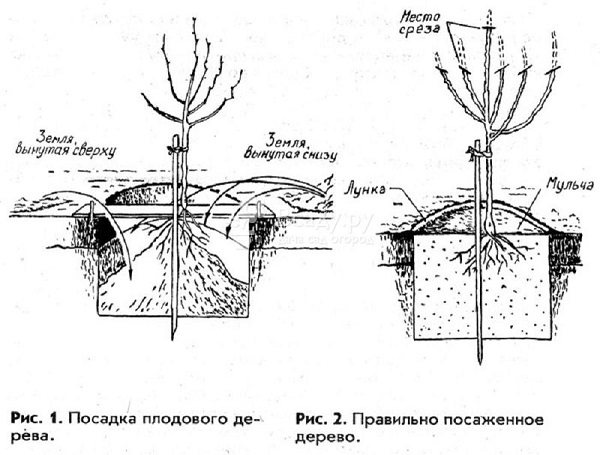

Preparation of the landing pit.
Timing
Apple trees of late varieties can be planted in the spring at the end of April or at the end of September, but Better still in the fall.
Technology
Place the seedling in the hole, straighten the roots, cover with soil. Do not deepen the seedling, as the root collar should be 5-7 cm above the surface.
Watch the video on how to plant an apple tree:
From the history
Apple cinnamon striped
This apple variety was bred by breeders back in 1957. It's kind of a hybrid. A little later, the work of Sedov and Trofimova was recognized as elite. The native place of apples of this family is the Baltic countries. A humid climate develops there, so it is difficult for the tree to tolerate drought, which so often happens in the south.
This variety was recognized as the best at German farmer exhibitions. Trees are able to survive average winter hardiness. If frosts hit in the spring, they can damage the buds, and the farmer will lose his crop.
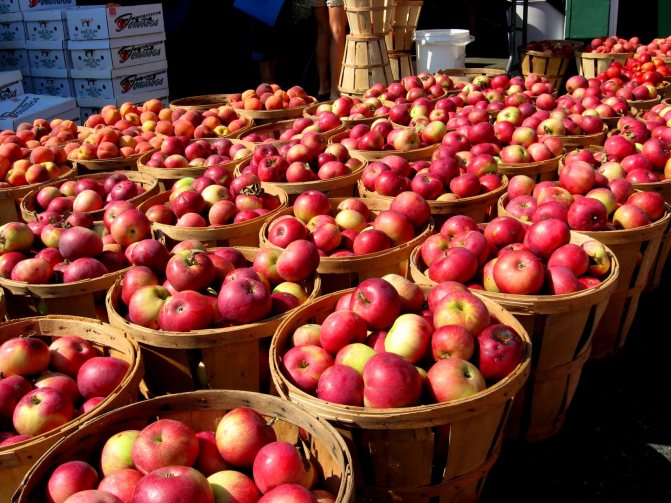

The farmer may lose his harvest
Growing
The feeding area of the apple tree depends on the rootstock:
- On the vigorous rootstock - 20-25 m²,
- On the average height rootstock - 12-15 m²,
- On the dwarf - 9 m².
Agrotechnics
If your apple tree grows on black soil, then you should not carry out top dressing often, if on the sandthen fertilize every year.
In the second or third year in spring, it follows add organic, about 10 kg per 1 m², for the first year, fertilizer is not added, as the soil is prepared when planting.
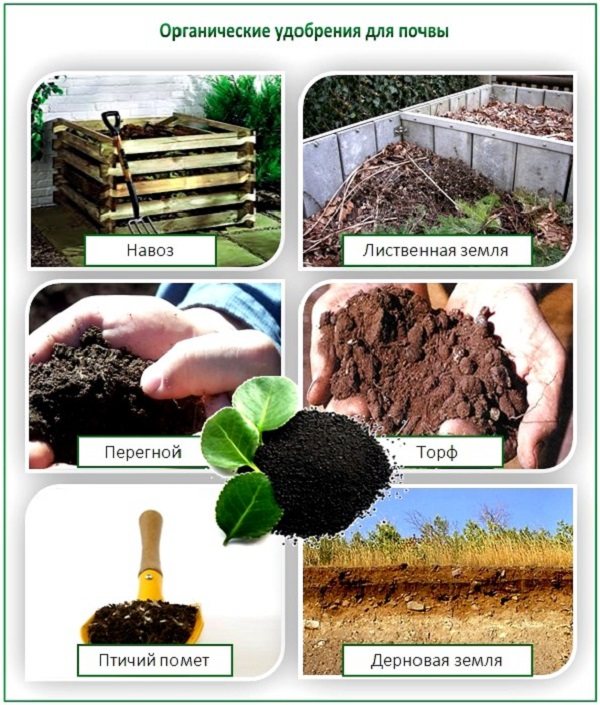

Types of organic fertilizers.
After planting trees, cut off 80-100% of the flowers, then the apple trees will take root better. In subsequent years, you can normalize the harvest, that is, cut off up to 50% of the recently formed ovaries, which are 1-3 cm in diameter, so that the remaining apples grow larger and sweeter.
Watering
Watering the tree 4-5 times a month, poured a bucket of clean water under the tree in the morning, and after that in the evening the same amount of water.
The apple tree needs watering in August, when apples are poured and flower buds are laid, which will yield next year.
Watering ends in August, to stop the growth of branches, then the tree will be more resistant to frost.
Loosening and pulling weeds
It is necessary pull out weeds and loosen to a shallow depth priming.
Preparing for winter
In autumn mulch the trunk circle rotted horse manure, and also wrap the stem with agrotex or other material.
Advice! To prevent rodents from damaging the apple tree, you can wrap it with a special rodent net.
How to use apples
For the maximum benefit from eating apples, they must be eaten fresh. Any thermal effect can reduce or even destroy vitamin C. And vitamin C does not have the ability to accumulate independently in the human body, and its presence must be constant. The aroma of apples, which is provided by the presence of phytoncides in them, is able to fight many pathogens of various diseases. If there is a sick person in the family who has had a heart attack, he is strongly advised to introduce fresh apples into his daily menu.
Pruning and shaping the crown
When a seedling is planted in the ground, then before that cut branches by 1/3, then the tree will lay the crown faster. Cut the apple tree every year in April, it is required that the buds have not yet blossomed.
When completely pruning a branch, do not leave a stump, cut a branch at the base... Cut off those branches that, when loaded with apples, fall to the ground. When pruning young shoots leave the strongest and those that stand upright cut the rest.
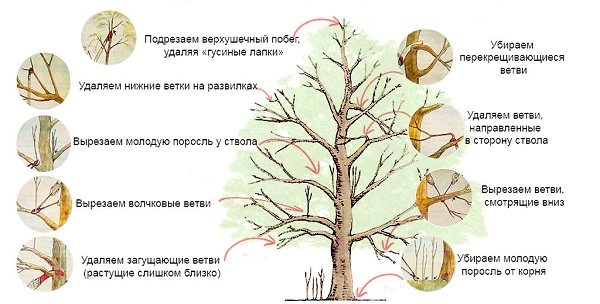

General principles of pruning apple trees.
Attention! You can cut no more than ¼ of the total weight of the branches, otherwise the tree may die.
The following video will tell you how to properly cut an apple tree:
One-year-old apple trees
When buying an annual apple tree with open roots, the root system and the aerial part should be equalized. If this is required, then they make sanitary pruning of the part that is above the ground. Cut the trunk at a height of 100 cm, this will stimulate the growth of lateral branches, which will later become the skeletal branches of the first tier.
All buds and branches from the soil surface to the first tier of skeletal branches are cut, this will be the trunk area. An underestimated bole will make it difficult to loosen the earth, picking apples, and an oversized bole can burn the sun.
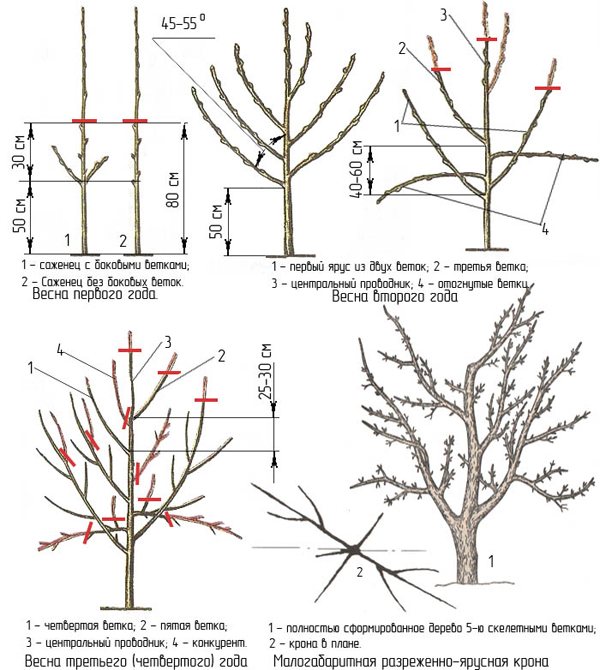

Apple pruning in the first three years.
If the tree has already grown branches, then first outline those that will be the first tier - these are 3-5 branches directed in different directions. If there is just a stem, then 5-8 buds are left, of which the first tier will form. And also the kidney, which is located above them, it should be directed in the opposite direction from the bend in the budding area, then the stem will be flat.
A continuation shoot will grow from the uppermost bud; it will replace the leader shoot. The branches that are separated from the trunk at an acute angle are cut off, and the remaining ones are shortened.
Watch the video, what are the nuances of pruning an annual apple tree:
What species does it belong to?
Apple trees "Orlovskoe Polesie" - with beautiful fruits, winter-hardy and fruitful representatives of the winter variety, which has its own immunity to the scab pathogen.
Resistance to the main disease of the culture is provided by the Vf gene. The variety is partially self-pollinated, resistant to the retention of hereditary traits.
For four years, the variety was tested in the conditions of the Central, Nizhnevolzhsky, Chernozem regions. It has been registered in the State Register since 2002.
Apple-tree Orlovskoe striped
On a dwarf rootstock
Landing
Dig holes with a diameter of 80 cm, but depth of about 60 cm... Drive a 1.5 m stake into each hole.
Separately place the top layer of soil from the pits, and separately the bottom one. Topsoil add organic matter, then mix and fill the hole. For 1 pit, 2-3 buckets of compost or humus, a glass of ash, a little superphosphate are enough. Plant an apple tree early autumn or spring.
The root collar of a seedling on a dwarf rootstock should rise above ground level 4-5 cm... Do not confuse the root collar and grafts, the grafts are located slightly above the root collar.
The roots of dwarf trees are close to the surface, because of this they are poorly fixed. When you place the seedling in the hole, then make sure the roots do not bend and gently sprinkle them with earth.
Advice! If you have a nearby groundwater, then plant on hills, pouring them with a height of about 0.5 m and a diameter of 1.5 m.
Make sure on no roots visible... Pull the wire over the stakes. Tie each apple tree to a support. After planting, dig holes and pour 2-3 buckets of clean water into each. Then mulch the soil.
Care
Water the trees all summer, pouring 4-5 buckets of clean water under a tree, and after watering, shallowly loosen the soil so as not to hurt the roots. They also loosen the soil after the rain. Stop watering the trees in August.
The amount of water that apple trees require also depends on the land. For sandy loam, about 4 buckets of water are required under one tree, and for loams, about 6 buckets of clean water.
Inspect the seedlings regularly: if you see diseased, dry, damaged branches, then cut them off.
They are fed only for 3 years after planting, this is done 2-3 times during the summer. A well-rotted mullein is used for feeding.
Very early in the spring spray the trunk from pests, you can spray it with a urea solution, and whitewash the trees themselves with chalk.
When flowering, you must not use any chemical pest control agents. It's best if you will pull out weeds and pick up pests mechanically.
On a semi-dwarf rootstock
Semi-dwarf trees grow best on chernozem, loam, sandy loam and sod-semi-zolic soils... And the apples harvested 2-3 years after disembarkation seedlings, while vigorous ones only for 4 years. Brackish soils, which have a high content of chloride and sulfate salts, are not at all suitable for tree growth.
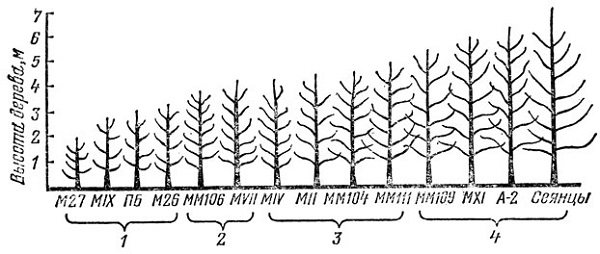

The influence of rootstocks on the size of apple trees: 1 - dwarf rootstocks; 2 - semi-dwarf rootstocks; 3 - semi-standard rootstocks; 4 - standard rootstocks.
For growing you need to water the trees abundantly, they are planted rather thickened and fed more heavily than apple trees on vigorous rootstocks. And the roots of semi-dwarf trees are very branched and located close to the surface.
Place for planting seedlings should not be blown by the winds and be illuminated by the sunnot be shaded. Better to plant on the eastern or southern slopes of the site. It is better to plant in the fall, then the root system will strengthen until spring and the apple tree will grow intensively in the spring. You can also do this in the spring, but do not be late with this, since the seedlings may have buds blooming, and then they may dry out.
Prepare every 3 m of the hole 0.5 m in diameter and 0.5 m in depth. Pour the dug out top layer of earth in one place, and the bottom layer on another.
Pour 1-2 buckets of ready-made compost into each hole, another 40 g of nitrophoska, then earth from the top layer, then mix.
Place a seedling in the hole, carefully spread the root system and pour soil from the top layer, and then from the bottom. Compact the earth the vaccination site should rise 7 cm above the soil... Make a hole around the seedling and pour 3-4 buckets of water into it. Next, mulch with humus with a layer of 5 cm.
Advice! For apple trees on a semi-dwarf rootstock, drip irrigation is best suited.
Until the middle of summer, the apple tree is fertilized with ammonium nitrate; from the middle of summer, phosphorus and potassium are used.
Disease protection
Spraying the crown and soil around the trunk is carried out at the beginning of spring, even before the buds begin to bloom. For preventive purposes, the crown is treated in early spring and late autumn with copper-containing preparations - copper sulfate or Bordeaux mixture.
In the fight against powdery mildew, a solution of colloidal sulfur is used - 80 g of the substance will be dissolved in a bucket of water.
Processing is carried out 5 times: in early spring, after blooming flower buds, then 3 more times every 2 weeks.
Plants suffering from cytosporosis are treated with copper sulfate. After the tree has faded, Hom is used. And to increase resistance to disease, nitrogen-containing preparations are introduced into the soil - Nitroammofosk or Nitrofosk.
Features of growing varieties in the regions
In outskirts of Moscow
Seedling placed on the site at the end of September.
In the Urals
In the Urals, a tree grown in stanza form.
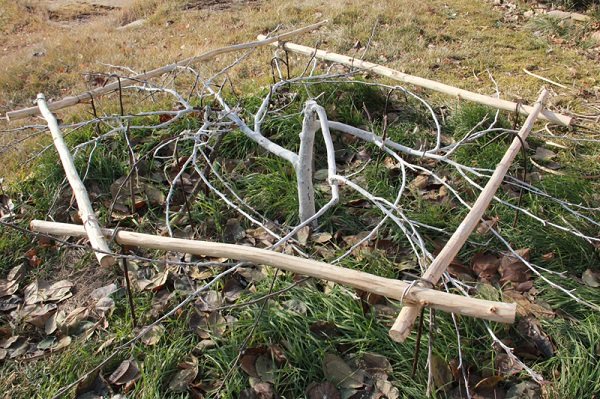

In the Urals, Orlovskoe striped is formed into stanza.
In the Leningrad region
In the Leningrad region, the soils are rather poor, therefore before boarding they need to be cooked thoroughly, scatter fertilizers.
The variety in the Leningrad region is the best plant in a sunny placeprotected from the winds as much as possible, and as a rootstock use a winter-hardy skeleton builder.
Origin of culture
Apple-tree Orlovskaya striped
Orlovskoe striped is a fast-growing variety with apples of late autumn ripening.The culture was eaten at VNIISPK (All-Russian Scientific Research Institute for Selection of Fruit Crops) in 1957. The agrarians T.A. Trofimova and E.N.Sedov became the originators of the form.
The breeders received a hybrid by crossing:
- apple McIntosh (Macintosh), a popular frost-hardy American cultivar for autumn and winter ripening;
- culture of domestic origin Bessemyanka Michurinskaya, known for tasty fruits and high yields.
In 1967, the uniform was recognized as elite. In 1970, Orlovskoe striped began to be tested. In 1986, according to its results, the form received the status of a variety and was registered in the Russian State Register of Breeding Achievements.
Orlovskoe striped is officially zoned in the following regions of the Russian Federation:
- Central;
- Central Black Earth;
- Middle Volga;
- Northwest;
- Volgo-Vyatsky.
Dome decoration
In order for the apple tree to lay the crown faster, after planting its branches are pruned by a third. Further, annually, before the buds bloom, sanitary and regulatory pruning is performed.
Before the first fruiting, the crown is rounded. In this case, tops, intersecting branches directed towards the trunk and branching downward, as well as young root shoots, are subject to removal. It is necessary to cut them off to the base, without leaving hemp and processing the cut with garden pitch.

